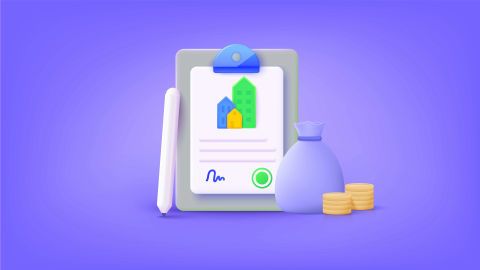Higher education at a renowned institute helps your children build the potential for a brighter future. You may be surprised how much of a difference the name of a good university can make on their resume. Moreover, regardless of whether your child chooses to study within the country or outside, an educational loan can help you fund all the financial requirements without straining your finances for other obligations.
If you own a property, why not use it to secure the funds you need for your child’s education? A loan against property by Bajaj Finance offers significantly lower interest rates compared to standard education loans, allowing you to save big while ensuring your child gets the education they deserve. Plus, the repayment flexibility and high loan amounts make it a smarter alternative to fund global academic aspirations. Get loan of up to Rs. 10.50 crore against your property within 72 hours* of the approval.
However, as you will need to repay the borrowed funds, applying for a loan with the most nominal interest rate is a must! This way, you can ensure successful repayment with ease. Wondering how to acquire such rates? Then, take a look at how you can bag an educational loan in India with the lowest interest rates.
Ensure you meet all the education loan eligibility criteria
The eligibility criteria vary amongst lenders. Check your preferred lender’s education loan eligibility criteria to ensure you qualify for an education loan. This way, you can avoid borrowing from a lender at high-interest rates. Being eligible also works to your benefit as you can negotiate the interest rate with the lender and bag one of the lowest student loan rates. Being eligible also works to your benefit as you can negotiate the interest rate with the lender and bag one of the lowest student loan rates.
When considering education funding, a loan against property stands out with its extended repayment tenure, often up to 15 years. This flexibility lets you spread out payments comfortably, reducing financial strain. Moreover, with competitive interest rates, you are assured affordability without compromising on your other financial priorities. By using your property as collateral, you can unlock access to large funds of up to Rs. 10.50 crore—it is a smart way to manage your finances with ease! Get funds within 72 hours* of approval.
Consider a loan against property instead of a regular educational loan
Instead of an education loan, you can also take a loan against property to pay for higher education. As this is a secured loan, you can expect to find the cheapest student loans. So, you can enjoy lower interest rates even when you need to borrow a high loan amount to pay for all requirements, from flight tickets to tuition and lifestyle needs. What’s more, unlike an education loan, a loan against property offers higher funding based on the value of your property. An education loan funds 70%-95% of the amount you need; however, you can get the entire amount you need with a mortgage loan. Notably the repayment tenor of an education loan can stretch up to 15 years, while an education loan offers a tenure only as long as 15 years.
Look for an affordable lender
Various education loan providers in India offer different interest rates. While you may be tempted to borrow from your bank based on your relationship with the institute for years, consider NBFCs too. For instance, Bajaj Finserv offers loans at nominal interest rates with easy repayment. Further, there are no hidden charges that add to your expenses.
While education loans often cap funding, a loan against property allows you to borrow a substantial amount based on your property’s value. This ensures you can comfortably cover tuition fees, living expenses, and other miscellaneous costs without worrying about additional funding sources. Leverage the power of your property to fulfil multiple financial needs. Get a loan against property with simple application process.
Choose convenient EMI options
You can use the education loan calculator and calculate your EMIs conveniently. With a longer tenure, you can reduce your EMIs conveniently. A lender is less likely to trust your repayment abilities if you borrow a heavy amount on a short tenure. While opting for a longer and more reasonable tenure tenor, remember not to choose too long as it will only increase your interest expenses. You can also consider availing Flexi-loan facilities that allow you to borrow as you need and incur interest only on the used amount. Thus, you are prepared for unexpected expenses without paying extra interest.
Central Government Interest Subsidy Scheme for education loans
The Central Government Interest Subsidy Scheme for education loans in India is designed to provide financial assistance to economically weaker students pursuing professional and technical courses. It offers an interest subsidy during the moratorium period, covering the duration of the course plus one year or six months post-employment, whichever comes first. The scheme is applicable to approved public and private banks, with the government directly crediting the interest subsidy to the student's loan account.
With a loan against property, you enjoy the liberty to use the funds as needed—be it tuition, travel expenses, or accommodation. Unlike traditional education loans, there are no rigid restrictions, offering you unmatched convenience and peace of mind during this crucial phase. Get a loan of up to Rs. 10.50 crore with the option of interest-only EMIs during the initial tenure.
The eligibility criteria is based on family income and course selection, and students should apply through their respective banks. It aims to reduce the financial burden of education loans and promote higher education opportunities. Be sure to refer to the latest government guidelines for the most current information.
How to reduce education loan interest rates
Reducing education loan interest rates can be achieved through various strategies:
- Explore government interest subsidy schemes
- Seek merit-based scholarships to lower the loan amount
- Negotiate with lenders for lower rates
- Consider loan refinancing or consolidation after graduation
- Enroll in auto-pay for potential interest rate reductions
- Improve your credit score to become eligible for lower rates
- Request co-signer release to potentially lower rates
- Choose federal loans with fixed interest rates
- Inquire about loyalty discounts from your existing lender
- Make extra payments to reduce the overall interest paid
- Consider loan forgiveness programs for specific career paths
Each strategy has its own requirements and effectiveness, so it is important to research and consult financial experts to determine the best approach for your situation.
DISCLAIMER:
While care is taken to update the information, products, and services included in or available on our website and related platforms/websites, there may be inadvertent inaccuracies or typographical errors or delays in updating the information. The material contained in this site, and on associated web pages, is for reference and general information purpose and the details mentioned in the respective product/service document shall prevail in case of any inconsistency. Subscribers and users should seek professional advice before acting on the basis of the information contained herein. Please take an informed decision with respect to any product or service after going through the relevant product/service document and applicable terms and conditions. In case any inconsistencies observed, please click on reach us.
*Terms and conditions apply








